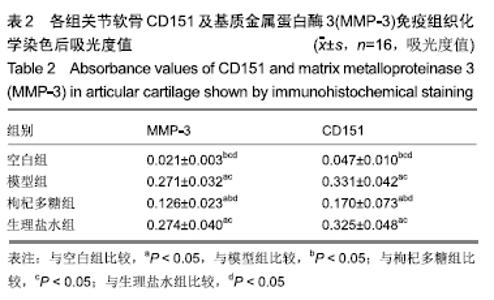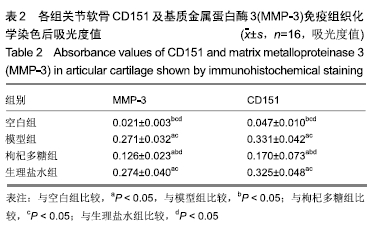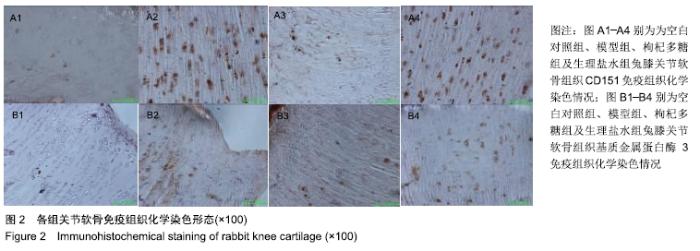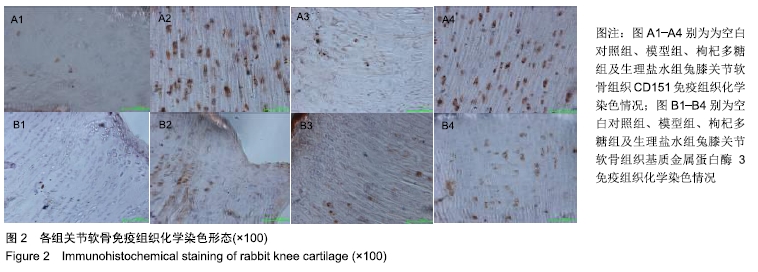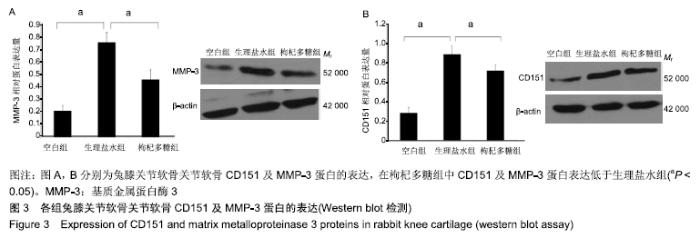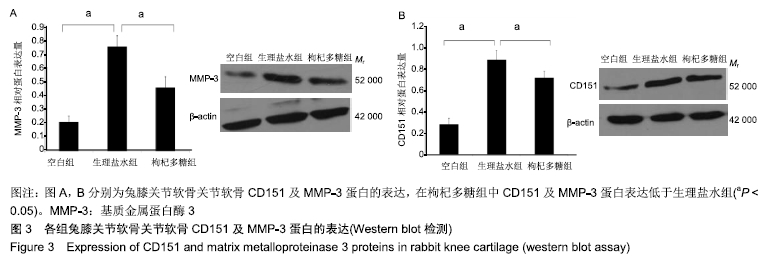[1] CRUZ R, RAMIREZ C, ROIAS OI, et al. Menisectomized miniature Vietnamese pigs develop articular cartilage pathology resembling osteoarthritis. Pathol Res Pract. 2015;211(11):829-838.
[2] ZHOU S, THORNHILL TS, MENG F, et al. Influence of osteoarthritis grade on molecular signature of human cartilage. J Orthop Res. 2016;34(3):454-462.
[3] ZHOU Q, XU C, CHENG X, et al. Platelets promote cartilage repair and chondrocyte proliferation via ADP in a rodent model of osteoarthritis. Platelets. 2016;27(3): 212-222.
[4] TAO R, WANG S, XIA X, et al. Pyrroloquinoline quinone slows down the progression of osteoarthritis by inhibiting nitric oxide production and metalloproteinase synthesis. Inflammation. 2015; 38(4):1546-1555.
[5] FUJITA Y, SHIOMI T, YANAGIMOTO S, et al. Tetraspanin CD151 is expressed in osteoarthritic cartilage and is involved in pericellular activation of pro-matrix metalloproteinase 7 in osteoarthritic chondrocytes. Arthritis Rheum. 2006;54(10): 3233-3243.
[6] 孙棒菊,左平国.枸杞多糖功效研究及应用状况[R].东南大学学报(医学版),2010,29(2):209-215.
[7] GAO J, CHEN C, LIU Y, et al. Lycium barbarum polysaccharide improves traumatic cognition via reversing imbalance of apoptosis/regeneration in hippocampal neurons after stress. Life Sci. 2015;121:124-134.
[8] BIE M, LV Y, REN C, et al. Lycium barbarum polysaccharide improves bipolar pulse current induced microglia cell injury through modulating autophagy. Cell Transplant. 2015;24(4): 419-428.
[9] DU S, HAN B, LI K, et al. Lycium barbarum polysaccharides protect rat corneal epithelial cellsagainst ultraviolet b-induced apoptosis by attenuating the mitochondrial pathway and inhibiting JNK phosphorylation. Biomed Res Int. 2017;2017: 5806832.
[10] ROGART JN, BARRACH HJ, CHICHESTER CO. Articular collagen degradation in the Hulth-Telhag model of osteoarthritis. Osteoarthritis Cartilage. 1999;7(6):539-547.
[11] MANKIN HJ, LIPPIELLO L. The glycosaminoglycans of normal and arthritic cartilage. J Clin Invest. 1971;50(8): 1712-1719.
[12] 方锐,艾力江•阿斯拉,卢勇,等.兔骨性关节炎模型构建及早中晚期的特点[J].中国组织工程研究与临床康复,2010,14(7): 1218-1222.
[13] 刘倩,韦建瑞,张雷,等.枸杞多糖通过抑制NF-κB信号通路保护脂多糖损伤的人脐静脉血管内皮细胞增殖活性与分泌功能[J].暨南大学学报,2017,38(3):240-246.
[14] 戚筠,尚桂莲,邹瑞梅,等.枸杞多糖对MIN6细胞增殖活性和凋亡的影响[J].国际内分泌代谢杂志,2013,5(33):298-301.
[15] 李小璐,陈南雄,马雅玲.枸杞多糖对糖尿病大鼠视网膜病理改变及其VEGF表达的影响[J].中华实验眼科杂志,2014,4(32): 334-339.
[16] CHEN L, LI W, QI D, et al. Lycium barbarum polysaccharide protects against LPS-induced ARDS by inhibiting apoptosis, oxidative stress, and inflammation in pulmonary endothelial cells. Free Radic Res. 2018;52(4):480-490.
[17] JING L, JIA XW. Lycium barbarum polysaccharide arbitrates palmitate-induced apoptosis in MC3T3 E1 cells through decreasing the activation of ERS mediated apoptosis pathway. Mol Med Rep. 2018;17(2):2415-2421.
[18] YU Y, WU X, PU J, et al. Lycium barbarum polysaccharide protects against oxygen glucose deprivation/reoxygenation- induced apoptosis and autophagic cell death via the PI3K/Akt/mTOR signaling pathway in primary cultured hippocampal neurons. Biochem Biophys Res Commun. 2018;495(1):1187-1194.
[19] GE JB, LU HJ, SONG XJ, et al. Protective effects of LBP on cerebral ischemia reperfusion injury in mice and mechanism of inhibiting NF-κB, TNF-α, IL-6 and IL-1β. Zhongguo Zhong Yao Za Zhi. 2017;42(2):326-331.
[20] YANG DM, ZHANG JQ, FEI YF. Lycium barbarum polysaccharide attenuates chemotherapy-induced ovarian injury by reducing oxidative stress. J Obstet Gynaecol Res. 2017;43(10):1621-1628.
[21] 王雨,苗永霸,王银,等.枸杞多糖含药血清对大鼠骨髓间充质干细胞成骨诱导过程及Wnt信号通路的影响[J].宁夏医科大学学报, 2017,39(5):525-529.
[22] ZHANG H, ZHENG L, YUAN Z. Lycium barbarum polysaccharides promoted proliferation and differentiation in osteoblasts. J Cell Biochem. 2019;120(4):5018-5023.
[23] ZHOU J, PANG H, LI W, et al. Liu Effects of lycium barbarum polysaccharides on apoptosis, cellular adhesion, and oxidative damage in bone marrow mononuclear cells of mice exposed to ionizing radiation injury. BioMed Res Int. 2016; 2016:4147879.
[24] LIANG W, YUE Z. Lycium barbarum polysaccharides promote osteoblasts viability by regulating microRNA-17/PTEN. Life Sci. 2019;225:72-77.
[25] YU N, SONG N, YING C, et al. The estrogen like protective effect of Lycium barbarum polysaccharides in reducing oxidative stress on myocardial cells from ovariectomized rats. Mol Med Rep. 2019;19(3):2271-2278.
[26] ZHENG G, REN H, LI H, et al. Lycium barbarum polysaccharide reduces hyperoxic acute lung injury in mice through Nrf2 pathway. Biomed Pharmacother. 2019;111: 733-739.
[27] ZHANG B, WANG M, WANG C, et al. Endogenous calcium attenuates the immunomodulatory activity of a polysaccharide from Lycium barbarum L. leaves by altering the global molecular conformation. Int J Biol Macromol. 2019;123: 182-188.
[28] LI Q, ZHANG Z, LI H, et al. Lycium barbarum polysaccharides protects H9c2 cells from hypoxia-induced injury by down-regulation of miR-122. Biomed Pharmacother. 2019; 110:20-28.
[29] BO R, LIU Z, ZHANG J, et al. Mechanism of Lycium barbarum polysaccharides liposomes on activating murine dendritic cells. Carbohydr Polym. 2019;205:540-549.
[30] 郝雪琦,关文霞,丁彦琴,等.枸杞多糖对慢性低氧大鼠外周血单个核细胞中HIF-1α、VEGF mRNA和蛋白表达的影响[J].宁夏医科大学学报,2019,41(1):14-18, 23.
|


